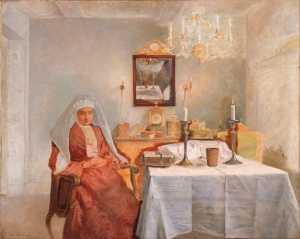
Isidor Kaufmann – Shabbos
We must be very quiet in front of this painting. It exudes a stillness and peace that envelopes us and makes us lower our voices. We whisper, “Shabbos has come!”
And as we stand in the special section of the Jewish Museum’s permanent collection devoted to Shabbos, we can see that this late and unfinished painting by Isidor Kaufmann has a special message for us to take home for Shabbos.
Kaufmann was a Hungarian painter who made a very successful career of painting traditional Hasidic life in Galicia, Poland and the Ukraine in the late 19th and early 20th century. His success reached its pinnacle when his painting The Rabbi’s Visit was bought by Emperor Franz Josef and then given to the Vienna Museum of Fine Art. For Kaufmann, who was a highly trained academic artist, the shtetl and the shtiblach were the key to his success in the Viennese art world, especially among the assimilated and cosmopolitan Jewish middle class. He would make numerous field trips to village after village in Eastern Europe bringing back sketches and field notes detailing costumes, character types, portraits, interior views and other visual research to help him recreate what he had seen into polished genre paintings of Jewish life.
Normally this type of “bourgeois realism” produced dry folkloric observations suitable for sociological research or, worst still, nostalgic exercises expressing shallow stereotypes of a world gone by. When done for a Jewish audience, this type of work was calculated to evoke a quick and easy piety, a kind of surrogate prayer for the growing mass of assimilated Jews.
This is not so with Kaufmann’s paintings. His paintings are generally well composed and relatively free of the superficial details that dominates this genre. His best work tends to be single portraits of young Hasidic Jews, dressed in their Yom Tov best. He created a surprising number of paintings about pious Jewish women. Since the majority of his sitters are in the prime of life there is none of the cloying sentimentality of old rebbes learning or decrepit old Hasidim arguing a fine point of Gemara. Rather, his portraits are subtle character studies that reveal considerable insight into the psychology of the individuals. He transforms the elaborate costumes and finely studied backgrounds (usually highly artificial settings before a Torah curtain) into solid compositional elements that provide a structured environment for the character of the sitter to emerge.
The painting Friday Evening is a genre scene that attempts a larger subject matter. Not just a closely observed portrait of a woman in a very old fashioned folk costume (remember this is painted in 1920), it attempts to evoke the deeper atmosphere of erev Shabbos. While most paintings of women concerning Shabbos focus on candle lighting, Kaufmann has chosen instead a time just after lighting, while she is ostensibly waiting for her husband to arrive home from shul. This view of a Shabbos not yet complete with a husband, a seuda or wine, allows us to partake in the anticipation of Shabbos and therefore ponder what is missing and wonder why. The air of contemplation is deepened by the use of the mirror that reflects the two candlesticks, a reflection that distills Shabbos down to a set table of lights, challah and wine. Of course Shabbos is much more. We notice the repeated sets of two that echo through out the painting; two candlesticks, the reflection of these, two wall sconces, the kiddush cup and the open tehillim, all make us sharply aware that she is alone, with only the faintest outline of another chair to suggest her partner. Although the painting is unfinished, it shines with light and air and is at the same time incredibly introspective. All the elements express the contemplation of the sitter without distracting detail. This is, of course, the special message Kaufmann has for us. Shabbos as an island in time to reflect and perhaps, to contemplate. The slight melancholy mood reveals that he saw this as a distant and perhaps unattainable quality (hence her antique costume). But we know that it is possible and, in fact, a quality much needed. We live such busy lives that when Shabbos comes, most of us continue to be busy, albeit with Shabbos itself. This painting tells us to take a moment of Shabbos and be still. Allow the silence to envelop us, become part of us and bless us with a peace unique to Shabbos itself.
JEWISH MUSEUM
1109 Fifth Avenue, New York, N.Y.